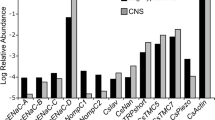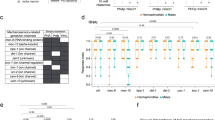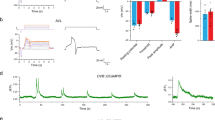Abstract
The nematode Caenorhabditis elegans is commonly used as a genetic model organism for dissecting integration of the sensory and motor systems1. Despite extensive genetic and behavioural analyses that have led to the identification of many genes and neural circuits involved in regulating C. elegans locomotion behaviour1, it remains unclear whether and how somatosensory feedback modulates motor output during locomotion. In particular, no stretch receptors have been identified in C. elegans, raising the issue of whether stretch-receptor-mediated proprioception is used by C. elegans to regulate its locomotion behaviour. Here we have characterized TRP-4, the C. elegans homologue of the mechanosensitive TRPN channel. We show that trp-4 mutant worms bend their body abnormally, exhibiting a body posture distinct from that of wild-type worms during locomotion, suggesting that TRP-4 is involved in stretch-receptor-mediated proprioception. We show that TRP-4 acts in a single neuron, DVA, to mediate its function in proprioception, and that the activity of DVA can be stimulated by body stretch. DVA both positively and negatively modulates locomotion, providing a unique mechanism whereby a single neuron can fine-tune motor activity. Thus, DVA represents a stretch receptor neuron that regulates sensory–motor integration during C. elegans locomotion.
This is a preview of subscription content, access via your institution
Access options
Subscribe to this journal
Receive 51 print issues and online access
$199.00 per year
only $3.90 per issue
Buy this article
- Purchase on SpringerLink
- Instant access to full article PDF
Prices may be subject to local taxes which are calculated during checkout




Similar content being viewed by others
References
Samuel, A. D. & Sengupta, P. Sensorimotor integration: locating locomotion in neural circuits. Curr. Biol. 15, R341–R343 (2005)
Montell, C. The TRP superfamily of cation channels. Sci STKE 2005, re3 (2005)
Xu, X. Z. S. & Sternberg, P. W. A C. elegans sperm TRP protein required for sperm-egg interactions during fertilization. Cell 114, 285–297 (2003)
Sidi, S., Friedrich, R. W. & Nicolson, T. NompC TRP channel required for vertebrate sensory hair cell mechanotransduction. Science 301, 96–99 (2003)
Walker, R. G., Willingham, A. T. & Zuker, C. S. A Drosophila mechanosensory transduction channel. Science 287, 2229–2234 (2000)
Chalfie, M. & White, J. in The Nematode Caenorhabditis elegans (ed. Wood, W. B.) 337–391 (Cold Spring Harbor Laboratory Press, New York, 1988)
Cronin, C. J. et al. An automated system for measuring parameters of nematode sinusoidal movement. BMC Genet. 6, 5 (2005)
Hall, W. C. & Nicolelis, M. in Neuroscience (eds Purves, D. et al.) 347–368 (Sinauer Associates, Sunderland, 2001)
Goldberg, C. J. et al. in Research Into Spinal Deformities (ed. Stokes, I. A. F.) 53–56 (International Research Society of Spinal Deformities, Amsterdam, 1999)
Ernstrom, G. G. & Chalfie, M. Genetics of sensory mechanotransduction. Annu. Rev. Genet. 36, 411–453 (2002)
Goodman, M. B. & Schwarz, E. M. Transducing touch in Caenorhabditis elegans. Annu. Rev. Physiol. 65, 429–452 (2003)
Sawin, E. R., Ranganathan, R. & Horvitz, H. R. C. elegans locomotory rate is modulated by the environment through a dopaminergic pathway and by experience through a serotonergic pathway. Neuron 26, 619–631 (2000)
Lints, R. & Emmons, S. W. Patterning of dopaminergic neurotransmitter identity among Caenorhabditis elegans ray sensory neurons by a TGFβ family signaling pathway and a Hox gene. Development 126, 5819–5831 (1999)
White, J. G., Southgate, E., Thomson, J. N. & Brenner, S. The structure of the nervous system of the nematode Caenorhabditis elegans. Phil. Trans. R. Soc. Lond. B 314, 1–340 (1986)
Kahn-Kirby, A. H. et al. Specific polyunsaturated fatty acids drive TRPV-dependent sensory signaling in vivo. Cell 119, 889–900 (2004)
Wang, J. W., Wong, A. M., Flores, J., Vosshall, L. B. & Axel, R. Two-photon calcium imaging reveals an odor-evoked map of activity in the fly brain. Cell 112, 271–282 (2003)
Nakai, J., Ohkura, M. & Imoto, K. A high signal-to-noise Ca2+ probe composed of a single green fluorescent protein. Nature Biotechnol. 19, 137–141 (2001)
Way, J. C. & Chalfie, M. The mec-3 gene of Caenorhabditis elegans requires its own product for maintained expression and is expressed in three neuronal cell types. Genes Dev. 3, 1823–1833 (1989)
Driscoll, M. & Chalfie, M. The mec-4 gene is a member of a family of Caenorhabditis elegans genes that can mutate to induce neuronal degeneration. Nature 349, 588–593 (1991)
Richmond, J. E., Davis, W. S. & Jorgensen, E. M. UNC-13 is required for synaptic vesicle fusion in C. elegans. Nature Neurosci. 2, 959–964 (1999)
Cattaert, D. & Le Ray, D. Adaptive motor control in crayfish. Prog. Neurobiol. 63, 199–240 (2001)
Acknowledgements
We thank J. Nakai for the G-CaMP plasmid; B. Perry for help with deletion libraries; C. Cronin for assistance with data analysis; G. Schindelman, N. Moghal, C. Montell and A. Ward for comments; and G. Medina, E. Larkspur and R. Mahapatra for technical assistance. Some strains were obtained from the Caenorhabditis Genetics Center. This work was supported by the University of Michigan BSSP Scholar Program (X.Z.S.X.), the Helen Hay Whitney Foundation (X.Z.S.X), and the Howard Hughes Medical Institute, of which P.W.S. is an investigator.
Author information
Authors and Affiliations
Corresponding author
Ethics declarations
Competing interests
Reprints and permissions information is available at npg.nature.com/reprintsandpermissions. The authors declare no competing financial interests.
Supplementary information
Supplementary Figure 1
TRP-4 expression pattern. (PDF 150 kb)
Supplementary Figure 2
Representative calcium imaging traces of various mutants. (PDF 166 kb)
Supplementary Figure 3
DVA neurons lacking TRP-4 can still respond to membrane depolarization. (PDF 152 kb)
Supplementary Figure 4
Amplitude of calcium response versus bending angles. (PDF 81 kb)
Supplementary Methods
Additional methods not described in the main text. (DOC 37 kb)
Rights and permissions
About this article
Cite this article
Li, W., Feng, Z., Sternberg, P. et al. A C. elegans stretch receptor neuron revealed by a mechanosensitive TRP channel homologue. Nature 440, 684–687 (2006). https://doi.org/10.1038/nature04538
Received:
Accepted:
Issue Date:
DOI: https://doi.org/10.1038/nature04538



